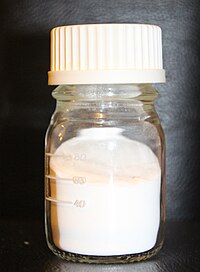Sodium hydrosulphite
 |
|
 |
|
 |
|
| Names | |
|---|---|
| Other names
D-Ox
Hydrolin Reductone Sodium hydrosulfite Sodium sulfoxylate Sulfoxylate Vatrolite Virtex L |
|
| Identifiers | |
|
3D model (JSmol)
|
|
| ChEBI | |
| ECHA InfoCard | 100.028.991 |
| EC Number | 231-890-0 |
|
PubChem CID
|
|
| RTECS number | JP2100000 |
| UN number | 1384 |
|
|
|
|
| Properties | |
| Na2S2O4 | |
| Molar mass | 174.107 g/mol (anhydrous) 210.146 g/mol (dihydrate) |
| Appearance | white to grayish crystalline powder light-lemon colored flakes |
| Odor | faint sulfur odor |
| Density | 2.38 g/cm3 (anhydrous) 1.58 g/cm3 (dihydrate) |
| Melting point | 52 °C (126 °F; 325 K) |
| Boiling point | Decomposes |
| 18.2 g/100 mL (anhydrous, 20 °C) 21.9 g/100 mL (Dihydrate, 20 °C) |
|
| Solubility | slightly soluble in alcohol |
| Hazards | |
|
EU classification (DSD) (outdated)
|
Harmful (Xn) |
| R-phrases (outdated) | R7, R22, R31 |
| S-phrases (outdated) | (S2), S7/8, S26, S28, S43 |
| NFPA 704 | |
| Flash point | 100 °C (212 °F; 373 K) |
| 200 °C (392 °F; 473 K) | |
| Related compounds | |
|
Other anions
|
Sodium sulfite Sodium sulfate |
|
Related compounds
|
Sodium thiosulfate Sodium bisulfite Sodium metabisulfite Sodium bisulfate |
|
Except where otherwise noted, data are given for materials in their standard state (at 25 °C [77 °F], 100 kPa).
|
|
|
|
|
| Infobox references | |
Sodium dithionite (also known as sodium hydrosulfite) is a white crystalline powder with a weak sulfurous odor. It is the sodium salt of dithionous acid. Although it is stable under most conditions, it will decompose in hot water and in acid solutions. It can be obtained from sodium bisulfite by the following reaction:
Raman spectroscopy and single-crystal X-ray diffraction studies of sodium dithionite in the solid state reveal that sodium dithionite exists in different forms. In one anhydrous form, the dithionite ion has C
2 geometry, almost eclipsed with a 16° O-S-S-O torsional angle. In the dihydrated form (Na
2S
2O
4.2H
2O), the dithionite anion has a shorter S-S bond length and a gauche 56° O-S-S-O torsional angle.
The weak S-S bond causes the dithionite anion to dissociate into the [SO2]− radical anion in aqueous solution, which has been confirmed by ESR spectroscopy. It is also observed that 35S undergoes rapid exchange between S2O42− and SO2 in neutral or acidic solution, consistent with the weak S-S bond in the anion.
Sodium dithionite is stable when dry, but is slowly oxidized by air when in solution. Even with the absence of air, solutions of sodium dithionite deteriorate due to the following reaction:
...
Wikipedia

